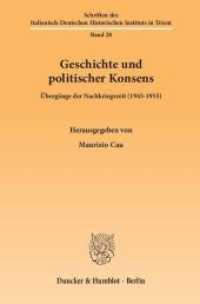基本説明
The present collection of articles places special emphasis on empirical evidence obtained from large-scale analyses of computerised corpora of learner Englishes (such as the International Corpus of Learner English) and of second-language varieties of English (such as the International Corpus of English). It addresses questions such as 'Are the phenomena we find in ESL and EFL varieties features or errors?' or 'How common and wide-spread are features across contact varieties of English?'
Full Description
The articles in this volume are intended to bridge what Sridhar and Sridhar (1986) have called the 'paradigm gap' between traditional SLA research on the one hand and research into institutionalised second-language varieties in former colonial territories on the other. Since both learner Englishes and second-language varieties are typically non-native forms of English that emerge in language contact situations, it is high time that they are described and compared on an empirical basis in order to draw conceptual and theoretical conclusions with regard to their form, function and acquisition. The present collection of articles places special emphasis on empirical evidence obtained from large-scale analyses of computerised corpora of learner Englishes (such as the International Corpus of Learner English) and of second-language varieties of English (such as the International Corpus of English). It addresses questions such as 'Are the phenomena we find in ESL and EFL varieties features or errors?' or 'How common and wide-spread are features across contact varieties of English?'
Contents
1. Introduction: Bridging a paradigm gap (by Hundt, Marianne); 2. Modal auxiliaries in second language varieties of English: A learner's perspective (by Biewer, Carolin); 3. English in Cyprus: Second language variety or learner English? (by Bongartz, Christiane); 4. From EFL to ESL: Evidence from the International Corpus of Learner English (by Gilquin, Gaetanelle); 5. Formulaic sequences in spoken ENL, ESL and EFL: Focus on British English, Indian English and learner English of advanced German learners (by Gotz, Sandra); 6. Studying structural innovations in New English varieties (by Gut, Ulrike); 7. Interrogative inversion as a learner phenomenon in English contact varieties: A case of Angloversals? (by Hilbert, Michaela); 8. Overuse of the progressive in ESL and learner Englishes - fact or fiction? (by Hundt, Marianne); 9. Typological profiling: Learner Englishes versus indigenized L2 varieties of English (by Szmrecsanyi, Benedikt); 10. A principled distinction between error and conventionalized innovation in African Englishes (by Rooy, Bertus van); 11. Discussion forum: New Englishes and Learner Englishes - quo vadis? (by Hundt, Marianne); 12. Bionotes; 13. Index







